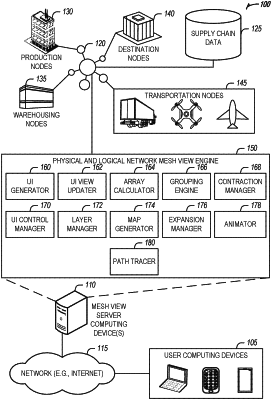| CPC G06F 16/9024 (2019.01) [G06F 16/904 (2019.01); G06F 16/906 (2019.01)] | 21 Claims |

|
1. A system for generating an aggregated view of a graph network data structure having a geographical layer and a network layer comprising:
at least one processor; and
memory including instructions that, when executed by the at least one processor, cause the at least one processor to perform operations to:
cause display of the graph network data structure it a user interface presented on a display device coupled to the system;
obtain a selection of a portion of the graph network data structure via the user interface;
identify nodes in the portion of the graph network data structure;
determine geolocation data for each of the identified nodes;
calculate geographical boundaries for the portion of the graph network data structure using the geolocation data;
generate a geographical map using the geographical boundaries;
generate a network map that connect visual representations of the nodes with edges that interconnect the nodes;
generate a physical network view for display in the user interface as an aggregated view of the geographical map and the network map by fixing the visual representations of the nodes of the network map to the geographical map using the geolocation data, wherein the geographical map represents a physical layer of the aggregated view and the network map represents a logical layer of the aggregated view;
cause display of the aggregated view in the user interface with a first set of controls that correspond to the physical layer and a second set of controls that correspond to the logical layer;
determine, based on a grouping attribute of a node of the portion of the graph network data structure, that the node is eligible to be grouped;
identify a set of child nodes for the node by evaluating incoming edges and outgoing edges of the node present in the portion of the graph network data structure:
generate a group for the node using the grouping attribute:
add the identified set of child nodes to the group;
aggregate data for the incoming edges into an aggregated incoming data set and data for the outgoing edges into an aggregated outgoing data set;
generate a visual representation of an outgoing edge using the aggregated outgoing data set and a visual representation of an incoming edge using the aggregated incoming data set;
generate a visual representation of the group for display in the user interface in the logical layer; and
display the visual representation of the outgoing edge and the visual representation of the incoming edge proximate to the visual representation of the group in the logical layer.
|